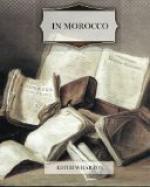Such an adventure initiates one at the outset into the stern facts of desert motoring. Every detail of our trip from Tangier to Rabat had been carefully planned to keep us in unbroken contact with civilization. We were to “tub” in one European hotel, and to dine in another, with just enough picnicking between to give a touch of local colour. But let one little cog slip and the whole plan falls to bits, and we are alone in the old untamed Moghreb, as remote from Europe as any mediaeval adventurer. If one lose one’s way in Morocco, civilization vanishes as though it were a magic carpet rolled up by a Djinn.
It is a good thing to begin with such a mishap, not only because it develops the fatalism necessary to the enjoyment of Africa, but because it lets one at once into the mysterious heart of the country, a country so deeply conditioned by its miles and miles of uncitied wilderness that until one has known the wilderness one cannot begin to understand the cities.
We came to one at length, after sunset on that first endless day. The motor, cleverly patched up, had found its way to a real road, and speeding along between the stunted cork-trees of the forest of Mamora brought us to a last rise from which we beheld in the dusk a line of yellow walls backed by the misty blue of the Atlantic. Sale, the fierce old pirate town, where Robinson Crusoe was so long a slave, lay before us, snow-white in its cheese-coloured ramparts skirted by fig and olive gardens. Below its gates a stretch of waste land, endlessly trailed over by mules and camels, sloped down to the mouth of the Bou-Regreg, the blue-brown river dividing it from Rabat. The motor stopped at the landing-stage of the steam-ferry; crowding about it were droves of donkeys, knots of camels, plump-faced merchants on crimson-saddled mules, with negro servants at their bridles, bare-legged water-carriers with hairy goat-skins slung over their shoulders, and Arab women in a heap of veils, cloaks, mufflings, all of the same ashy white, the caftans of clutched children peeping through in patches of old rose and lilac and pale green.
Across the river the native town of Rabat lay piled up on an orange-red cliff beaten by the Atlantic. Its walls, red too, plunged into the darkening breakers at the mouth of the river, and behind it, stretching up to the mighty tower of Hassan, and the ruins of the Great Mosque, the scattered houses of the European city showed their many lights across the plain.
IV
THE KASBAH OF THE OUDAYAS
Sale the white and Rabat the red frown at each other over the foaming bar of the Bou-Regreg, each walled, terraced, minareted, and presenting a singularly complete picture of the two types of Moroccan town, the snowy and the tawny. To the gates of both the Atlantic breakers roll in with the boom of northern seas, and under a misty northern sky. It is one of the surprises of Morocco to find the familiar African pictures bathed in this unfamiliar haze. Even the fierce midday sun does not wholly dispel it—the air remains thick, opalescent, like water slightly clouded by milk. One is tempted to say that Morocco is Tunisia seen by moonlight.




